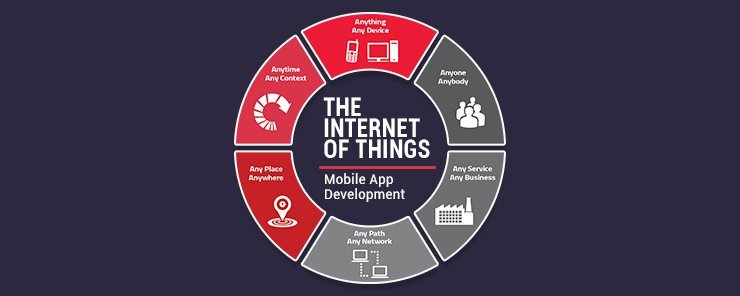
IoT- Internet of Things has become a trending topic in the mobile app development ecosystem these days. The cause for a sudden growth spurt in the domain of IoT includes mobile apps and their app development software.
Through mobile applications, various devices are connected with people and IoT helps in linking these various devices to one another.
The linked devices cover all things from a sensor implanted automobile and freezer to a fitness band and a parking door, all of these are linked to the same network which enables the data generated by various devices to be exchanged quickly and this will ultimately help in the simplification of human life.
At present, mobile apps are ruling the market. Operating as a link for progressive businesses, mobile apps together with mobile app development software are being used for creating intelligent devices which can benefit multi-dimensional aspects of human life.
Thus, mobile apps have generated the premise for the growth and emergence of the Internet of Things.
Coming up with a mobile app has become a necessity for organisations to last longer in the competition and gives them an edge over their competitors too. Furthermore, a mobile app helps people have quick access irrespective of their location and background.
Now, IoT is already bringing reforms to the mobile app development front. In near future, IoT is going to generate a huge number of jobs in this domain.
But, to reach the final objective of making people’s life simpler, mobile developers should primarily pass through the pains of making infrastructure and platforms from the scratch.
Although, there is one crucial distinction which is that mobile apps are usually developed in such a way that they take benefit of the unique peculiarities which mobile devices offer.
For instance, a heart rate monitoring app could be developed to take benefit of the heart rate sensor of a mobile phone.
With the skyrocketing development in IoT, its impact is becoming visible in a lot of other domains of the industry. There is an emergence of new concepts like smart homes, smart cities, smart cars and many more.
With so much going on in the domain of IoT, mobile app development process has undergone some major changes that are discussed in detail below:
1. Selection of a Home Device
Selecting a home device is related to the interconnectivity of various devices through IoT, which means that when selecting a home device, one needs to select a device that can be connected to the rest of the devices . Selecting the home device is a crucial task which you need to carefully execute in the initial phase of the app development process. If your technology concentrates more on the portability part, you should consider something like a smartphone which is compact and manageable as the home device. But, if your technology needs to be backed up by extensive processing power, you should consider the personal computer as the home device.
2. Combining Connectivity Options
Interconnectivity of various gadgets over the IoT system demands a steady connection to work . Present technology enables us to integrate such devices in multiple ways. One can utilize Bluetooth, WiFi, NFC, mobile data, etc. to join such devices to the same system. You should give space to multiple connections while developing the application. A perfect IoT device is the one which can work on multiple connections.
3. Expanding Accessibility Alternatives
The accessibility options for an app vary from device to device. Some of these devices function through their touchscreen feature whereas others can be operated by a mouse and keyboard. The ideal IoT device is the one which permits access through gesture control module. Based on the devices which you plan to link via the network, it may require you to pick more than one of the accessibility alternatives.
4. Finding Integration Functionality
When working on the development of IoT, it may require you to explore the merged functionality of different devices. When working on the development of the mobile app, you should consider how several devices may or may not operate collectively in delivering the desired outcome. Therefore, after accurately evaluating several traits of different devices, you can go ahead with the development of a complete mobile app.
5. Testing and Security
The trial phase of a mobile app development involves a rigorous testing process for IoT devices to uncover any loopholes which these particular devices may have. You should never compromise on the security aspect of an app if it is frequently communicating with the consumer’s personal data. For instance, social media apps like Facebook, Instagram, Twitter, etc.
In the coming times, the fate of mobile app development seems to be demanding but promising due to endless innovative and exciting opportunities. Although, the standard of quality will continue to be a permanent as well as a significant element in the development process. The apps which are going to be introduced will be revolutionary for both large as well as the specialized markets. Various professions and organisations concerned with this field have great times waiting ahead for them in the mobile app development ecosystem.
The continuous evolution of the IoT and mobile apps will result in a greater connected environment. Productive efforts are being applied to develop cloud-based apps. The mobile app technology is going to evolve to catch up with the changes in the demands of the users.


